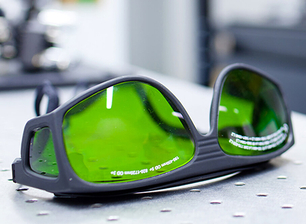Laser engraving offers so many benefits for a large number of industries, such as automotive, aerospace and medicine and thanks to systems such as the N-Lase series, a flexible range of options has enabled laser technology and its benefits to be more accessible than ever. Nonetheless, laser machines can be very dangerous, especially for your eyes and skin. If you’re working with a laser and need to wear laser safety glasses, you may be wondering to yourself: How do my laser safety glasses work?
Why Do We Need Safety Glass?
The type of hazard posed by a laser system depends on its power and its wavelength (colour). For example, one of the greatest hazards is normally to the eyes. Fiber lasers present one of the highest hazards of any laser because the light is transmitted to the back of the eye but is not visible, meaning that the usual protective responses we have such as blinking or looking away won't help in the way we think they might. In fact, light entering the eye in this way can cause permanent damage to our retina, resulting in a blind spot - or worse still, damage to the optic nerve. Long term exposure to 1µm radiation can also cause cataracts on the cornea of the eye.
Ultimately, laser safety glasses work by stopping direct, reflected, and scattered laser beams and radiation from getting into your eye, where they could cause your retina to be damaged or destroyed.
How do they Work?

No matter the level of protection, every pair of laser safety glasses works on this simple principle: blocking laser light from reaching the eye. Protecting your eyes is incredibly important because your retina does not have pain receptors that alert you to potential damage. As a result, serious eye damage can occur without any warning, which means that extreme care must be taken while working with laser light and radiation.
Laser safety glasses are designed to disrupt certain wavelengths of light. These particular wavelengths are blocked while the rest of the light is filtered through specially designed lenses, making it possible to work with lasers safely (and not in the dark!). Another factor that determines how much light is filtered is the optical density (OD) of the lens in use. Optical density is essentially how much light is absorbed by the lens and determines the strength at which they are able to block
waves of light.
Not your Average Lenses
There are two types of laser safety lenses, and they are definitely not the same as your standard glasses lens!
Glass
There are several wavelengths that require glass protection. These filters typically allow more visible light to be transmitted through the lens and are best suited for use around mid-to high-power density lasers.
Polycarbonate
Polycarbonate filters are super lightweight and impact-resistant. Less expensive than glass filters, polycarbonate filters now offer a wide range of wavelength absorption and achieve higher visual light transmission than ever before. These filters are best suited for low- to mid-power density lasers and can also be customized to meet specified needs.
Conclusion
Laser technology is exciting and can bring a whole host of benefits to businesses in a wide variety of sectors. That being said, it's a powerful technology that does not come without safety risks. Here are some do's and don'ts to consider buying and using a laser marking system. It's important to always familiarize yourself with the SOP (Standard Operating Procedure) and safety procedures associated with the laser system. But, most importantly, always wear your laser safety glasses!
If you'd like to learn more about the laser engraving systems we have to offer, visit our website. Alternatively, you can
Call: +(0)1948660011
Email: info@needhamlaser.com


